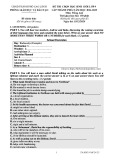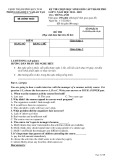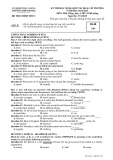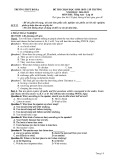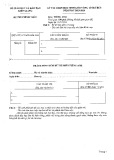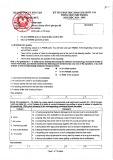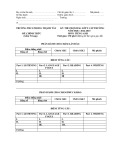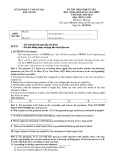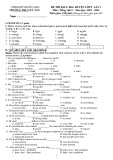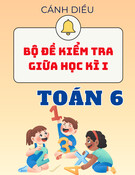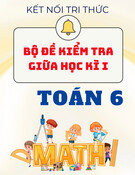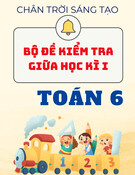
S GD&ĐT QU NG BÌNHỞ Ả
Đ CHÍNH TH CỀ Ứ
K THI CH N Ỳ Ọ ĐI TUY N Ộ Ể
D THI ỰCH N H C SINH GI I QU C GIA Ọ Ọ Ỏ Ố
NĂM H C 2022-2023Ọ
Khóa ngày 20 tháng 9 năm 2022
Môn thi: TI NG ANHẾ
S BÁO DANH:……………Ố
BÀI THI TH NH TỨ Ấ
Th i gian: 1ờ80 phút (không k th i gian giao đ)ể ờ ề
Đ g m có ề ồ 12 trang
L u ýư: Thí sinh làm bài trên t gi y thiờ ấ
I. LISTENING (50/200 points)
H NG D N PH N THI NGHE HI UƯỚ Ẫ Ầ Ể
Bài nghe g m 4 ph n; m i ph n đc nghe 2 l n, m i l n cách nhau 05 giây; m đu m i ph nồ ầ ỗ ầ ượ ầ ỗ ầ ở ầ ỗ ầ
nghe có tín hi u.ệ
M i h ng d n cho thí sinh đã có trong đ bài nghe.ọ ướ ẫ ề
Part 1. For questions 1-5, listen to a piece of news about “How to save love from pessimism” and
decide whether these statements are True (T), False (F), or Not given (NG).
1. Despite being pessimistic about many aspects of life, everyone is optimistic about love-seeking.
2. The first impression about a possible partner is sometimes deceptive.
3. There are no perfect beings that actually exist in real life.
4. A couple need to be compatible with each other in order to have a great relationship.
5. It is necessary to see somebody die to be able to love probably.
Your answers:
1. 2. 3. 4. 5.
Part 2. For questions 6-10, listen to a talk about the future of fashion and answer the questions. Write
NO MORE THAN FOUR WORDS taken from the recording for each answer.
6. What is capable of forecasting fashion trends with high precision?
......................................................................................................................................................
7. As evidenced by H&M's unsold clothes, what could have untold repercussions?
......................................................................................................................................................
8. Besides superfluous production, what aspect of fashion could be diminished thanks to the adoption of
machine learning?
......................................................................................................................................................
9. To create new clothes, what will Amazon’s AI designer be doing aside from duplicating well-known styles?
......................................................................................................................................................
10. What is the ZOZO?
......................................................................................................................................................
Part 3. You will hear a conversation between Monica and Joseph about the “buy nothing” day. For
questions 11-15, choose the answer (A, B, C or D) which fits best according to what you hear.
11. What is Joseph’s thought on shopping?
A. Shopping is the most lucrative industry for businesses.
B. Shopping supports the nation’s economy.
C. Shopping guides people towards honest deeds.
D. Shopping is the favorite pastime for most people.
1

12. What does Monica say about shopping?
A. People feel the need to shop for a variety of reasons.
B. Shopping experiences need to be redefined.
C. Compulsive shopping does not make financial sense.
D. Personal needs remain the top priority as far as a buying decision is made.
13. What does Joseph suggest about his spending habit?
A. He spends money wisely because he understands the value of money.
B. He is mistakenly branded a spendthrift.
C. He is not as stingy as people might think.
D. He spends freely on himself and others.
14. Monica gives the advice that when shopping, we should
A. give more priority to products made by women and children.
B. calculate the impact our consumption makes on the environment.
C. be informed of the circumstances under which our purchases are manufactured.
D. make sure that the goods we buy are still in usable conditions.
15. At the end of the discussion, Monica and Joseph agree that
A. they will spend the next day window-shopping.
B. Joseph should do shopping on alternate days.
C. it is impossible to change Joseph’s shopping habits.
D. one day without shopping is worth a try.
Your answers:
11. 12. 13. 14. 15.
Part 4. For questions 16-25, listen to a talk on the effects of sleep deprivation and supply the blanks
with the missing information. Write NO MORE THAN THREE WORDS taken from the recording for
each answer.
-In an experiment in 1965, Randy Garder didn’t sleep for 11 days, which resulted in his inability to
focus his eyes and his lost sense of touch on the second day. The following day saw him
(16) __________________. He encountered various health issues by the last day, including the onset
of (17) _____________________.
-Sleep is influenced by both biological and environmental signals. The non-REM sleep in which our
body recharges itself is the result of an increase in (18) ______________________. Rather than
being a (19) ______________________, sleep deprivation causes adverse bodily damage. People
who lose sleep may suffer from physical problems such as high blood pressure, diabetes, obesity and
(20) _________________; and mental poblems such as cognitive impairment and unreal sensory
experiences. A minority of the world’s population are the victim of a rare genetic disorder called
(21) _____________________which results in sleeping problems.
-During waking hours, the accumulated amount of adenosine, a byproduct of daily energy sources
induces huge sleep pressure. In fact, caffeine could inhibit adenosine’s (22) _________________,
keeping us awake. Other byproducts also need clearance, otherwise, they overwhelm our brain and
beget sleep deprivation.
-When a person is sleeping, the glymphatic system, a (23) ________________, counters the build-up
of waste products by removing toxic waste with cerebrospinal fluids. (24)_________________,
which act as the channels transporting immune cells, also aid in the removal of the brain's daily waste
products.
-While the restorative mechanisms behind sleep should be further investigated, falling into
(25)____________________ remains the best option to preserve our well-being.
2

II. LEXICO-GRAMMAR (25/200 points)
Part 1. For questions 26-45, choose the correct answer A, B, C, or D to each of the following questions.
26. The new company had been _______ with one problem after another and looked as if it were about to
go under.
A. glorified B. tainted C. fraught D. bewildered
27. One of the most powerful pressure groups in the country is the road and car _______, which opposes
any legislation that will increase taxes specifically for them.
A. branch B. folder C. segment D. lobby
28. Unfortunately, his report doesn't _______ with what we've learnt from other sources.
A. pally B. rally C. tally D. ally
29. The princess's nanny's autobiography really gives the _______ on life among the royals.
A. show-down B. know-how C. low-down D. look-out
30. His energy and optimism were a tribute, perhaps, to the ______ life he advocated.
A. deleterious B. abstemious C. amorphous D. deciduous
31. The choreographer _______his fingers in time to the music so that the dancers could pick up the tempo.
A. clenched B. snapped C. nudged D. beckoned
32. The shop wasn’t making much of a profit so in order to attract more customers, the owner
________some of the prices.
A. shelled out B. sold out C. marked down D. stocked up
33. Closure of schools took place _______falling numbers of pupils.
A. in the context of B. with regard to C. with a concern for D. in consideration of
34. I decided to lend my brother some money to _________ until he could find himself a job.
A. pull him over B. tide him over C. get him by D. put him up
35. The football club decided to _______ the team with a couple of world-class players.
A. beef up B. butter up C. dredge up D. drum up
36. The party of tourists ________ two hours late, dressed up in ball gowns.
A. rocked up B. worked up C. popped up D. flocked up
37. When the events involve people close to you, it’s very difficult to be objective and report the news ________.
A. meteorically B. impartially C. proverbially D. emphatically
38. Only the most basic and essential facts are required, stop adding more information, you are making
_____ of the presentation, Emily!
A. a song B. a meal C. a dish D. a scale
39. He called the success a(n) _____ of his party's free-market economic policy.
A. testimonial B. acclaim C. testament D. vindication
40. Sex is probably the most popular pastime in the history of life on Earth - which makes it all the more
ridiculous that so many of us have such a _____ way of talking about it.
A. tight-fisted B. mealy-mouthed C. thick-skinned D. light-fingered
41. The needs of today's children cannot be met by the traditional _____ of education we’re using, in
which emphasis is placed solely on theoretical knowledge.
A. prototype B. paradigm C. emblem D. epitome
42. Performance ________ is one basic issue of human resource development and management in an
enterprise to evaluate an employee’s productivity and capability.
A. appraisal B. judgment C. remuneration D. assessment
43. I am a doctor so I know what to do, please mind your own business and stop ________ on my toes.
A. stepping B. pinning C. treading D. rueing
44. Steve used to be easy to work with, but since his promotion he’s begun to________.
A. throw his weight around B. throw in the towel
C. throw him off balance D. throw a monkey wrench in the works
45. One of the defendants ________ and was on the run until his arrest.
A. jumped bail B. made bail C. stood bail D. posted bail
Your answers
3

26. 27. 28. 29. 30. 31. 32. 33. 34. 35.
36. 37. 38. 39. 40. 41. 42. 43. 44. 45.
Part 2. For questions 46-50, write the correct form of each bracketed word.
46. Sleeping during day and working when night comes sounds seemingly ______. (SCIENCE)
47. He was regarded as a____ winner as he beat his opponents in three straight sets. (RUN)
48. I cannot imagine why there are such _____ people in this world. Don’t they feel
any sympathy for the homeless?
(HEART)
49. Membership talks were launched in 2005, but progress has been slow, as several
EU states have serious ________ about Turkish EU membership.
(GIVE)
50. He talked with the _____ authority of the head of the family. (MAGISTRATE)
Your answers
46. 47. 48. 49. 50.
III. READING (70/200 points)
Part 1. For questions 51-60, read the following text and fill in the blank with ONE suitable word.
The Bwindi Impenetrable Forest in Uganda is impenetrable in more ways than (51) _______.
Not only is it nigh on impossible for visitors to trek through the thick undergrowth in their quest to spot
the famed guerrilla inhabitants of the area. (52) _______literally can the forest's former residents, the
Batwa pygmy people, penetrate it at all.
Strictly (53) _______ of course, the dense foliage does not prevent tourists from going in (54)
_______ of the great apes which dwell there; it just severely encumbers them as they trek. However,
notwithstanding the difficulty encountered as soon as they enter the leafy habitat, (55) _______ in mind
that at least they can access this magical place. Entry is not an option afforded any longer to its original
human inhabitants, the Batwa or Twa people.
The Batwa were evicted from the land in 1992 based on the Ugandan government’s desire to
make it exclusively a guerrilla reserve - great for the ape inhabitants, yet you can't help (56) _______
wonder how fair that was on the Batwa. They appear to have got the (57) _______ to say the least,
receiving little compensation on account of hot being official landowners (58) _______ their traditional
nomadic way of life.
Since that time, they have been in a never-ending struggle for their very existence. They cannot
afford to (59) _______ big and dream of a very cosy, rich lifestyle. Instead, they want only (60) _______
which everyone deserves - a decent existence.
Your answers:
51. 52. 53. 54. 55.
56. 57. 58. 59. 60.
Part 2. For questions 61-73, read the following passage and do the tasks that follow.
Conservation Strategies
A. Although estimates vary, it is believed that approximately 900 different animal species have died
out in the last 500 years. A further 35,000 species are officially recorded as at risk of extinction, though
this is unquestionably an underrepresentation of the true number under threat. The survival chances of
only a tiny proportion of the world's wildlife have been assessed, so it's highly likely that far more
species are at risk of dying out. In fact, estimates on the true number vary enormously but range from 10
million to almost 50 million. Experts have also calculated that 25% of the world's mammals are under
4

threat, and 40% of amphibians are endangered. Such statistics are undoubtedly alarming. However,
numbers alone are not enough to highlight the seriousness of the issue, or the solutions.
B. Of course, it's important to distinguish between cases of preventable animal extinction and
extinction that occurs due to natural evolutionary reasons. Somewhere between 90% and 99% of all the
species that have ever existed have died out. Many species gradually disappear when they are unable to
adapt to changing circumstances such as availability of food or the appearance of new predators. In these
cases, other species evolve to fill the vacant role. The Earth's ecosystems are complex networks of living
things, in which animals, plants and waterways are dependent on one another. Natural extinction helps to
maintain the planet's delicate ecological balance.
C. When left undisturbed, nature finds a way to restore itself. However, the natural balance of the
world's ecosystems is changing, leading to significant biodiversity loss. Construction, tourism, mining,
manufacturing and other aspects of human life are responsible for much of the environmental destruction
we see in the world nowadays. Such activities directly lead to the loss of natural habitats, increase
pollution and soil erosion, and also play a major role in climate change. All of this is having a disastrous
impact on the planet's wildlife. Species are disappearing at rates estimated to be between 1,000 and
10,000 higher than rates of natural extinction. There's no doubt that humans have a disproportionately
negative impact on the world. What's less clear is how best to resolve this.
D. Wildlife management is far from straightforward, especially given the fact that it requires vast
financial resources. To put this in context, it has been estimated that it costs over a million dollars a year
to save just one single species of condor bird native to one particular area of North America. Since there
are currently fewer than four hundred of these endangered condors in existence, saving each one comes
at a cost of over $2,500 a year. With this in mind, wildlife management often involves weighing up
competing environmental needs, and making painful strategic decisions to prioritise some species over
others. The factors influencing such decisions are extremely complex, and often controversial.
E. In recent years, the concept of "conservation triage" has gained increasing attention. This involves
leaving some species to face extinction in order to allocate more resources to species with a greater
chance of survival, or which are perceived to be more important in some way. Conservation triage
recognises that it makes sense to invest our limited resources in species that will have the best
environmental outcomes. However, there is no accepted formula to evaluate the relative merits of saving
one species over another. The lack of consensus regarding which species should be prioritised means that
wildlife agencies often adopt differing approaches when it comes to conservation efforts.
F. Some conservation strategies focus entirely on "flagship" species. These are animals promoted as
icons to raise public awareness of environmental issues. They are selected on the basis that they are
commonly regarded as attractive or charismatic, and therefore valued in society. For instance, the
possibility that the beloved giant panda may become extinct has highlighted the importance of protecting
natural habitats and having tighter controls against deforestation. However, while cute animals may
generate public sympathy, there is little evidence that this leads to significant environmental gains. In
fact, if images of flagship species appear too often in marketing, the public may even assume they are no
longer endangered.
G. Although flagship species may be "cute", the arguments for alternative approaches are more
compelling. It surely makes more sense to prioritise species which make the greatest overall contribution
to nature, regardless of whether they are perceived to be attractive. Keystone species perform essential
functions in ecosystems. For instance, elephants in the wild clear pathways for small animals. Insects and
5


